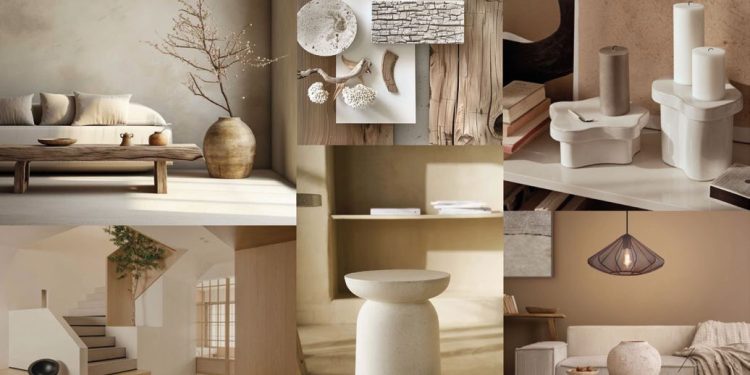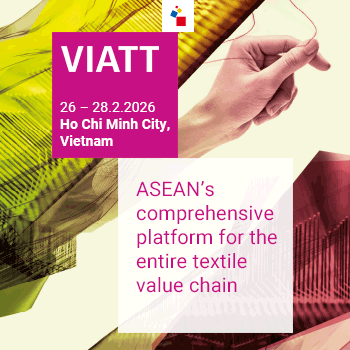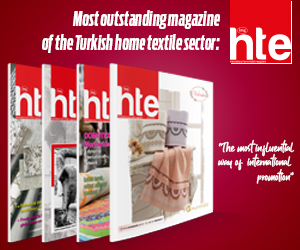We are living in an era defined by disruption and unpredictability—an “Unreal Reality” where design must do more than decorate; it must soothe, protect, and inspire. In this forward-looking trend analysis, renowned Dutch forecaster Milou Ket unveils six key interior themes that reflect the emotional needs and aesthetic desires of our time. As Artificial Intelligence and Big Tech reshape our environments, interiors respond with both high-tech materials and a renewed embrace of craftsmanship and sustainability. Expect to see the comforting warmth of textured textiles, the shimmering allure of metallics and gradients, and the power of bold personal expression. Whether through the flowing calm of Japanese minimalism or the vibrant spirit of modern maximalism, these trends invite us to curate interiors that not only reflect who we are—but who we are becoming.
We are currently navigating a time of Unreal Reality, shaped by upheaval, uncertainty, and complexity. Interest in color provides comfort during these times. Artificial Intelligence and the influence of Big Tech are becoming increasingly evident, even in the world of interiors. Sustainability and longevity are key priorities. Textures like ribs, ridges, flowing lines, and dynamic patterns are present across all themes. Reflective materials, such as iridescent, mirrored, shiny, metallic and aurora-like effects, contribute to a sense of otherworldliness. Gradients are also central, with flowing applications of both color and form. Textiles play a crucial role in offering warmth and emotional support. Alongside new carpet shapes, expect to see creatively designed tiles gaining significance.
The first theme, “Fluidity and Balance,” features rounded forms, Japanese influences, and timeless light hues combined with earth tones. The second theme, “Gradients and Transparency,” highlights soft pastels, synthetic materials, and curved forms. The third, “Ethnic & Crafted,” revisits traditional cultural aesthetics with a contemporary edge, expressed in warm, earthy colors. The fourth, “Color Kaleidoscope,” draws on vivid products, gradients, and modern art, featuring bright, energetic tones. The fifth theme, “Sustainable Nature,” is inspired by natural elements and eco-conscious materials, presented in greens, sand, terra, and clay tones. The sixth and final theme, “Individual Maximalism,” celebrates personal expression and uniqueness through luxurious, bold colors.

1.Fluidity & Balance
The first theme is titled “Fluidity and Balance”, featuring soft tones and light earthy hues. Texture continues to play a key role, with an emphasis on ribbed, ridged, and wave-like surfaces. Furniture often features rounded silhouettes, while arches are a recurring element in interior design. Irregular forms dominate in rugs, and a notable innovation is the use of uniquely shaped tiles, introduced in unexpected ways. Metallic finishes, such as silver, stainless steel, high gloss, and mirrored surfaces, add contrast to the organic aesthetic. These sleek materials are juxtaposed with natural, untreated elements like light and dark woods, raw concrete, and soft textiles. Straw and raffia also appear in interior items, frequently adorned with fringes. Sustainability and durability are central themes, drawing inspiration from unconventional materials such as fungi, seaweed, bacteria, soy, and corn, among others. Various forms of waste are being creatively transformed into materials like felt. There are clear minimalist influences, primarily from Scandinavian design, complemented by Japanese aesthetics. Stone and finely crafted objects often adopt primitive, organic shapes. Textiles, including rugs, cushions, and curtains, help soften the minimalistic environment and offer effective acoustic benefits. Patterns tend to be soft, blurred, or watercolor-like in appearance.
2.Gradients & Transparency
The second theme is titled “Gradients and Transparency.” It represents a modern and forwardthinking aesthetic, characterized by imaginative and surreal elements. This impression is reinforced by the materials used, predominantly synthetic ones like glass, acrylic, polyester resin, and plastic. Recycled polyester is also frequently utilized. The use of transparency, especially through gradient effects and shifting colors, lends a contemporary and dynamic feel to interiors. In printed designs, watercolor-style effects, cloud formations, random splashes, stains, and marbled textures are common. Patterns tend to be playful and whimsical, with curtains often made from sheer fabrics featuring gradient designs. Enhancing the surreal atmosphere, AI-generated renderings are increasingly prevalent. Gradients, iridescent effects, and layering with transparent materials continue to be important design elements. Architectural features reflect this theme through the use of arches, circular forms, and curved shapes. Details such as ridges and jagged edges also appear. Geometric shapes, stripes, stylized and hand-painted motifs are applied to textiles and carpets. Wall murals and acoustic panels often doubling as room dividers. We can also expect to see numerous 3D-printed items like vases and other decorative objects.
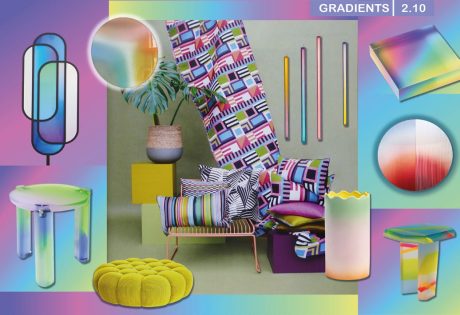
3.Ethnic & Crafted
In the direction “Ethnic & Crafted,” often presented in warm, nature-inspired hues, there is a clear appreciation for artisanal work and craftsmanship. While rooted in tradition, this trend introduces a contemporary twist. In contrast to the growing influence of Artificial Intelligence, the value of human touch and organic imperfection is increasingly embraced. Unique, one-off pieces are treasured for the character and individuality they bring to interiors. Traditional methods such as tiedye, shibori, and ikat are being revived by younger generations. Kilims, embellishments, and prints also feature prominently, sometimes reinterpreted in unexpected color combinations. Pattern mixing becomes a creative expression. A London-based African designer is reimagining both color palettes and form language. Natural materials are central, wood, stone, cork, bamboo, raffia, straw, reed, rattan, terracotta, linen, and hemp are all key. Many dyes are plant-based, sourced from a variety of natural products. The intricate handmade artistry from Morocco and broader Africa shines through in rugs, fabrics, embroidery, weaving, and ceramics. As in other style directions, texture plays a vital role. Handcrafted cushions and poufs incorporate fringe, tassels, and pompons, often hand-tufted to enhance tactile surfaces. Decorative items like masks and totems, occasionally adorned with beads, will appear. Products made from recycled or responsibly sourced materials are also gaining traction.
4.Color Kaleidoscope
This direction called “Color Kaleidoscope,” focuses on the use of bold, primary, and vivid colors. Color is increasingly seen as a symbol of positivity, which encourages its broader use in interior spaces. This can be achieved through techniques like color blocking or by incorporating multicolored items, such as rugs, lamps, vases, throws, and cushions that feature vibrant stripes or contrasting borders. Adjustable LED lighting with colored effects is also part of this trend. Interiors feature colorful wallpaper, room dividers, bed linens, curtains, and other decorative elements. Furniture often has rounded silhouettes, wavy lines, or bubbly forms. Circular and arched shapes are prominent. There are influences from Modern Art and Bauhaus, alongside more playful and expressive styles like the Memphis movement and modern reinterpretations of Bauhaus designs. Emphasis is placed on synthetic materials including glass, perspex, acrylic, polyester, resin, and various plastics. Textiles also play a key role, suitable for both indoor and outdoor use. Graphic patterns are essential, often in black and white and include stripes, geometric designs, checkerboards, pixelated images, and faceted effects. Digital renderings using Augmented Reality are becoming increasingly important, and the integration of Artificial Intelligence continues to evolve. Small, adaptable furniture pieces like stools and side tables are crucial in creating flexible interiors.
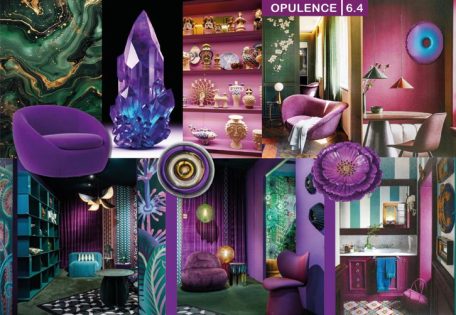
5.Sustainable Nature
In the styling direction “Sustainable Nature,” environmental awareness takes center stage. Sustainability, conscious consumption, and concern for climate change form the foundation of this theme. The aim is to reduce our ecological footprint by using alternative materials such as fungi, corn, banana leaves, bamboo, cardboard, vegan leather, and food industry waste like coffee grounds. Renewable natural resources like linen, hemp, raffia, rattan, and wood are essential, along with recycling. Nature, both flora and fauna, plays a key role in decorative elements such as wallcoverings, posters, cushions, and home accessories. Designs feature plants, foliage, insects, birds, and butterflies, often with a nostalgic touch. There is a renewed appreciation for wild nature, sometimes with a historical lens, showcasing exotic trees, palm plantations, vibrant birds, tropical flowers, tigers, monkeys, jaguars, and sea creatures. The color green is prominent for its calming and soothing qualities, also used in wall paints.
Botanical prints inspired by natural history illustrations are especially popular. Rugs and textile wall hangings take on unexpected, often floral-inspired shapes. Textures with relief, like tufting or high/low surfaces are significant. Green tones are frequently combined with dusty pinks and earthy terra shades.
6.Individual Maximalism
The “Individual Maximalism” trend draws its influence from opulence, glamour, nostalgia, and historical elements, often with a playful or whimsical edge. This style emphasizes a more personal and expressive approach to interiors, featuring treasured items, heirlooms, and unique finds. Gold accents, whether in delicate lines or small details are key, echoing the elegance of Art Deco patterns in wallpapers and textiles. The concept of the curiosity cabinet remains central, inspired by natural history, scientific illustration, botanical artwork, and exotic collections. Think of taxidermy, rare minerals, coral, seashells, glass domes, and classical statue fragments from ancient Greece and Rome. A contemporary interpretation introduces luminous effects on dark backgrounds, iridescence, aurora-like lights, and oil-slick finishes. Mid-century furniture continues to be relevant, particularly in plush velvets accented with gold or copper. Materials such as leather and welded metals are also incorporated. Deep, moody paint colors set a dramatic tone, while luxurious materials like marble and tiger eye, whether genuine or imitated, add a refined touch.


